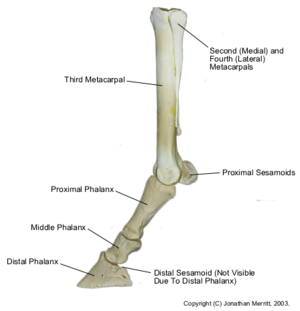Sesamoiditis
This article needs additional citations for verification. (January 2015) |
| Sesamoiditis | |
|---|---|
Orthopedics | |
| Symptoms | inflammation and pain on the bottom of feet |
| Causes | inflammation of the sesamoid bones |
Sesamoiditis is inflammation of the sesamoid bones.
Humans
Sesamoiditis occurs on the bottom of the foot, just behind the
Symptoms include inflammation and pain.
Sometimes a sesamoid bone is fractured. This can be difficult to pick up on
Among those who are susceptible to the malady are dancers, catchers and pitchers in baseball, soccer players, and American football players.[2][3]
Horses

In the horse it occurs at the horse's fetlock. The sesamoid bones lie behind the bones of the fetlock, at the back of the joint, and help to keep the tendons and ligaments that run between them correctly functioning.
Usually periostitis (new bone growth) occurs along with sesamoiditis, and the suspensory ligament may also be affected. Sesamoiditis results in inflammation, pain, and eventually bone growth.
Causes
In humans, excessive forces caused by sudden bending upwards of the big toe,
Treatment
Treatment in humans consists of
In horses, sesamoiditis is generally caused by excess stress on the fetlock joint. Conformation that promotes sesamoiditis include long pasterns, or horses with long toes and low heels.
Notable cases
- Josh Zeid, major league baseball pitcher[4]
- Melvin Upton, major league baseball player [5]
- JJ O'Donnell, football player for Gateshead FC[6]
References
- ISBN 9781451153828. Retrieved October 16, 2014.
- ISBN 9781556436666. Retrieved October 16, 2014.
- ISBN 9781449671907. Retrieved October 16, 2014.
- ^ "Astros P Zeid needs season-ending foot surgery". ESPN.com. Associated Press. July 30, 2014. Retrieved July 31, 2014.
- ^ "Upton to miss rest of spring training with inflammation in left foot". MLB.com. Retrieved February 27, 2015.
- ^ "Sunderland's Danny Graham helps fund Gateshead player's foot surgery". theguardian.com. Press Association. May 19, 2015. Retrieved May 20, 2015.
